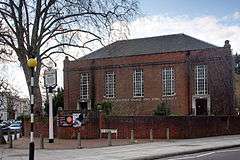English Folk Dance and Song Society
The English Folk Dance and Song Society (EFDSS, or pronounced 'EFF-diss'[3]) was formed in 1932 when two organisations merged: the Folk-Song Society and the English Folk Dance Society.[4] The EFDSS, a member-based organisation, was incorporated as a company limited by guarantee (no. 297142) in 1935 and became a registered charity (no. 305999) in England and Wales in 1963.
| Abbreviation | EFDSS |
|---|---|
| Formation | 1932 |
| Type | Nonprofit organization |
| Purpose | Research, study and promotion of English folk music and folk dance |
| Headquarters | London, United Kingdom |
Region served | England |
Chief Executive and Artistic Director | Katy Spicer[1] |
Budget | £1.5 million[2] |
| Website | www.efdss.org |
History
The Folk-Song Society, founded in London in 1898,[5] focused on collecting and publishing, primarily folk songs of Britain and Ireland although there was no formal limitation. Participants included: Lucy Broadwood, Kate Lee, Cecil Sharp, Percy Grainger, Ralph Vaughan Williams, George Butterworth, George Barnet Gardiner,[6] Henry Hammond, Anne Gilchrist and Ella Leather.[7]
The English Folk Dance Society was founded in 1911 by Cecil Sharp. Maud Karpeles was a leading participant. Its purpose was to preserve and promote English folk dances in their traditional forms, including Morris and sword dances, traditional social dances, and interpretations of the dances published by John Playford. The first secretary of the society was Lady Mary Hepburn-Stuart-Forbes-Trefusis; Trefusis Hall in the EFDSS HQ, Cecil Sharp House, is named after her.[8]
One of the greatest contributions that the EFDSS made to the folk movement, both dance and song, was the folk festival, starting with the Stratford-upon-Avon Festival in the 1940s and continuing with festivals in Whitby, Sidmouth, Holmfirth, Chippenham and elsewhere.
Publications
Since 1936 the EFDSS has published English Dance & Song at least four times a year. This has become the longest-established magazine devoted to folk music, dance and song in the country. English Dance & Song is aimed at stimulating the interest of the membership of the EFDSS, as well as the wider folk music and dance community.
Their regular scholarly publication is Folk Music Journal, published annually in December, which was formerly entitled the Journal of the English Folk Dance and Song Society until 1965. The work continues the earlier journals of the two societies: Journal of the Folk-Song Society, 1899–1931;[9] Journal of the English Folk Dance Society 191431.
Recent developments

In 1998, with the folk movement strongly supported by a number of other organisations and the seeds planted by EFDSS thriving, the EFDSS altered its strategy to focus on education and archiving, with its primary goal the development of the Vaughan Williams Memorial Library as the country's national archive and resource centre for folk music, dance and song.
In 2011 the society entered into a joint commission with Shrewsbury Folk Festival to create the Cecil Sharp Project, a multi-artist residential commission to create new works based on the life and collecting of Cecil Sharp. The project took place in March 2011, the artists involved being: Steve Knightley, Andy Cutting, Leonard Podolak, Jim Moray, Jackie Oates, Caroline Herring, Kathryn Roberts and Patsy Reid.[10]
In 2013, EFDSS launched The Full English, an ongoing archive project supported by the Heritage Lottery Fund, The Folklore Society, the National Folk Music Fund and the English Miscellany Folk Dance Group. This free and searchable resource of 44,000 records and over 58,000 digitised images is the world's biggest digital archive of traditional music and dance tunes.[11]
As well as folk music, the EFDSS is home to a number of performance artists, providing a regular performance platform for acts including the Ukulele Orchestra of Great Britain, the Massive Violins and the Swingle Singers.
See also
- Country Dance and Song Society, the American counterpart to the EFDSS
References
- "Staff". EFDSS. Retrieved 20 September 2018.
- "Report of the Year 2016-2017" (PDF). EFDSS. Retrieved 20 September 2018.
- Challenges of Designing the Roud Folk Song Index, Library of Congress, YouTube, 9:00
- Karpeles, Maud and Frogley, Alain (2007–2011). 'English Folk Dance and Song Society'. In: Grove Music Online, Oxford Music Online. Retrieved 24 October 2011. (subscription required).
- Keel, Frederick (1948). 'The folk song society' (1898–1948). Journal of the English Folk Dance & Song Society, Vol 5, No 3, December. Retrieved 23 October 2011 (subscription required).
- "G. B. Gardiner, folk song collector". Vaughan Williams Memorial Library. Archived from the original on 26 July 2011. Retrieved 6 June 2009.
- "Ella Mary Leather". Oxford University Press. Retrieved 8 August 2009.
- Seddon, Laura (15 April 2016). "British Women Composers and Instrumental Chamber Music in the Early Twentieth Century". Routledge. p. 171. Retrieved 24 April 2019 – via Google Books.
- Dean-Smith, Margaret (1951). 'The Preservation of English Folk Song in the Journal of the Folk Song Society'. Journal of the English Folk Dance and Song Society, vol 6, no 3 (December), pp 69–76. Retrieved 24 October 2011 (subscription required).
- "Cecil Sharp Project". English Folk Dance and Song Society. Archived from the original on 20 September 2018. Retrieved 20 September 2018.
- Chilton, Martin (21 June 2013). "'Staggering' digital folk music archive launched". The Daily Telegraph. Retrieved 26 February 2014.